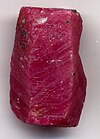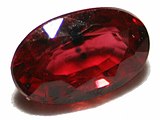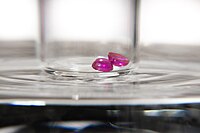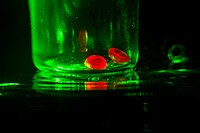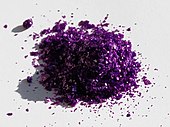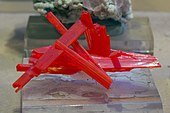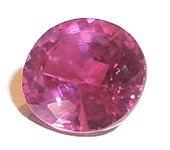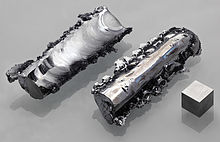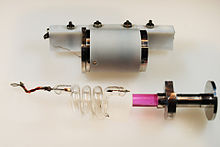From Wikipedia, the free encyclopedia.
Chromium, 24Cr
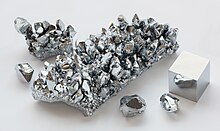 |
| Chromium |
|---|
| Appearance | silvery metallic |
|---|
| Standard atomic weight Ar, std(Cr) | 51.9961(6) |
|---|
| Chromium in the periodic table |
|---|
|
|
| Atomic number (Z) | 24 |
|---|
| Group | group 6 |
|---|
| Period | period 4 |
|---|
| Block | d-block |
|---|
| Element category | transition metal |
|---|
| Electron configuration | [Ar] 3d5 4s1 |
|---|
Electrons per shell
| 2, 8, 13, 1 |
|---|
| Physical properties |
|---|
| Phase at STP | solid |
|---|
| Melting point | 2180 K (1907 °C, 3465 °F) |
|---|
| Boiling point | 2944 K (2671 °C, 4840 °F) |
|---|
| Density (near r.t.) | 7.19 g/cm3 |
|---|
| when liquid (at m.p.) | 6.3 g/cm3 |
|---|
| Heat of fusion | 21.0 kJ/mol |
|---|
| Heat of vaporization | 347 kJ/mol |
|---|
| Molar heat capacity | 23.35 J/(mol·K) |
|---|
Vapor pressure
| P (Pa)
|
1
|
10
|
100
|
1 k
|
10 k
|
100 k
|
| at T (K)
|
1656
|
1807
|
1991
|
2223
|
2530
|
2942
|
|
| Atomic properties |
|---|
| Oxidation states | −4, −2, −1, +1, +2, +3, +4, +5, +6 (depending on the oxidation state, an acidic, basic, or amphoteric oxide) |
|---|
| Electronegativity | Pauling scale: 1.66 |
|---|
| Ionization energies |
- 1st: 652.9 kJ/mol
- 2nd: 1590.6 kJ/mol
- 3rd: 2987 kJ/mol
|
|---|
| Atomic radius | empirical: 128 pm |
|---|
| Covalent radius | 139±5 pm |
|---|
|
Spectral lines of chromium |
| Other properties |
|---|
| Natural occurrence | primordial |
|---|
| Crystal structure | body-centered cubic (bcc)
|
|---|
| Speed of sound thin rod | 5940 m/s (at 20 °C) |
|---|
| Thermal expansion | 4.9 µm/(m·K) (at 25 °C) |
|---|
| Thermal conductivity | 93.9 W/(m·K) |
|---|
| Electrical resistivity | 125 nΩ·m (at 20 °C) |
|---|
| Magnetic ordering | antiferromagnetic (rather: SDW) |
|---|
| Magnetic susceptibility | +280.0·10−6 cm3/mol (273 K) |
|---|
| Young's modulus | 279 GPa |
|---|
| Shear modulus | 115 GPa |
|---|
| Bulk modulus | 160 GPa |
|---|
| Poisson ratio | 0.21 |
|---|
| Mohs hardness | 8.5 |
|---|
| Vickers hardness | 1060 MPa |
|---|
| Brinell hardness | 687–6500 MPa |
|---|
| CAS Number | 7440-47-3 |
|---|
| History |
|---|
| Discovery and first isolation | Louis Nicolas Vauquelin (1794, 1797) |
|---|
| Main isotopes of chromium |
|---|
|
|
Chromium is a
chemical element with symbol
Cr and
atomic number 24. It is the first element in
group 6. It is a steely-grey,
lustrous, hard and brittle
transition metal. Chromium boasts a high usage rate as a
metal that is able to be highly
polished while resisting
tarnishing. Chromium is also the main additive in
stainless steel, a popular steel alloy due to its uncommonly high
specular reflection. Simple polished chromium reflects almost 70% of the
visible spectrum, with almost 90% of
infrared light being reflected. The name of the element is derived from the
Greek word χρῶμα,
chrōma, meaning
color, because many chromium compounds are intensely colored.
Ferrochromium alloy is commercially produced from
chromite by
silicothermic or
aluminothermic reactions and chromium metal by
roasting and
leaching processes followed by reduction with
carbon and then
aluminium. Chromium metal is of high value for its high
corrosion resistance and
hardness.
A major development in steel production was the discovery that steel
could be made highly resistant to corrosion and discoloration by adding
metallic chromium to form
stainless steel. Stainless steel and
chrome plating (
electroplating with chromium) together comprise 85% of the commercial use.
In the United States,
trivalent chromium (Cr(III))
ion is considered an
essential nutrient in humans for
insulin,
sugar and
lipid metabolism. However, in 2014, the
European Food Safety Authority, acting for the European Union, concluded that there was not sufficient evidence for chromium to be recognized as essential.
While chromium metal and Cr(III) ions are not considered toxic,
hexavalent chromium (Cr(VI)) is both toxic and
carcinogenic. Abandoned chromium production sites often require
environmental cleanup.
Physical properties
Atomic
Chromium is the fourth
transition metal found on the periodic table, and has an electron configuration of [
Ar] 3d
5 4s
1. It is also the first element in the periodic table whose ground-state electron configuration violates the
Aufbau principle. This occurs again later in the periodic table with other elements and their electron configurations, such as
copper,
niobium, and
molybdenum.
This occurs because electrons in the same orbital repel each other due
to their like charges. In the previous elements, the energetic cost of
promoting an electron to the next higher energy level is too great to
compensate for that released by lessening inter-electronic repulsion.
However, in the 3d transition metals, the energy gap between the 3d and
the next-higher 4s subshell is very small, and because the 3d subshell
is more compact than the 4s subshell, inter-electron repulsion is
smaller between 4s electrons than between 3d electrons. This lowers the
energetic cost of promotion and increases the energy released by it, so
that the promotion becomes energetically feasible and one or even two
electrons are always promoted to the 4s subshell. (Similar promotions
happen for every transition metal atom but one,
palladium.)
Bulk
Sample of pure chromium metal
Chromium has an unusually high
specular reflection in comparison to that of other transition metals. At 425
μm,
chromium was found to have a relative maximum reflection of about 72%
reflectance, before entering a depression in reflectivity, reaching a
minimum of 62% reflectance at 750
μm before rising again to reflecting roughly 90% of 4000
μm of
infrared waves.. When chromium is formed into a
stainless steel alloy and
polished,
the specular reflection decreases with the inclusion of additional
metals, yet is still rather high in comparison with other alloys.
Between 40% and 60% of the visible spectrum is reflected from polished
stainless steel. The explanation on why chromium displays such a high turnout of reflected
photon
waves in general, especially the 90% of infrared waves that were
reflected, can be attributed to chromium's magnetic properties. Chromium has unique magnetic properties in the sense that chromium is the only elemental solid which shows
antiferromagnetic ordering at room temperature (and below). Above 38 °C, its magnetic ordering changes to
paramagnetic.. The antiferromagnetic properties, which cause the chromium atoms to temporarily
ionize and bond with themselves, are present because the body-centric cubic's magnetic properties are disproportionate to the
lattice periodicity.
This is due to the fact that the magnetic moments at the cube's corners
and the cube centers are not equal, but are still antiparallel. From here, the frequency-dependent
relative permittivity of chromium, deriving from
Maxwell's equations in conjunction with chromium's
antiferromagnetivity, leaves chromium with a high infrared and visible light reflectance.
Passivation
Chromium metal left standing in air is
passivated by oxidation, forming a thin, protective, surface layer. This layer is a
spinel
structure only a few molecules thick. It is very dense, and prevents
the diffusion of oxygen into the underlying metal. This is different
from the spongy oxide that forms on iron and carbon steel, through which
elemental oxygen continues to migrate, reaching the underlying material
to cause continued further
rusting. Passivation can be enhanced by short contact with
oxidizing acids like
nitric acid. Passivated chromium is stable against acids. Passivation can be removed with a strong
reducing agent that destroys the protective oxide layer on the metal. Chromium metal treated in this way readily dissolves in weak acids.
Chromium, unlike such metals as iron and nickel, does not suffer from
hydrogen embrittlement. However, it does suffer from nitrogen
embrittlement, reacting with nitrogen from air and forming brittle nitrides at the high temperatures necessary to work the metal parts.
Isotopes
Naturally occurring chromium is composed of three stable
isotopes;
52Cr,
53Cr and
54Cr, with
52Cr being the most abundant (83.789%
natural abundance). 19
radioisotopes have been characterized, with the most stable being
50Cr with a
half-life of (more than) 1.8
×10
17 years, and
51Cr with a half-life of 27.7 days. All of the remaining
radioactive isotopes have half-lives that are less than 24 hours and the majority less than 1 minute. Chromium also has two
metastable nuclear isomers.
53Cr is the
radiogenic decay product of
53Mn (half-life = 3.74 million years). Chromium isotopes are typically collocated (and compounded) with
manganese isotopes. This circumstance is useful in
isotope geology. Manganese-chromium isotope ratios reinforce the evidence from
26Al and
107Pd concerning the early history of the
solar system. Variations in
53Cr/
52Cr and Mn/Cr ratios from several meteorites indicate an initial
53Mn/
55Mn ratio that suggests Mn-Cr isotopic composition must result from in-situ decay of
53Mn in differentiated planetary bodies. Hence
53Cr provides additional evidence for
nucleosynthetic processes immediately before coalescence of the solar system.
The isotopes of chromium range in
atomic mass from 43
u (
43Cr) to 67 u (
67Cr). The primary
decay mode before the most abundant stable isotope,
52Cr, is
electron capture and the primary mode after is
beta decay.
53Cr has been posited as a proxy for atmospheric oxygen concentration.
Chemistry and compounds
Chemical properties
The Pourbaix diagram for chromium in pure water, perchloric acid, or sodium hydroxide
Chromium is a member of
group 6, of the
transition metals. Chromium(0) has an electron configuration of [Ar]3d
54s
1, owing to the lower energy of the
high spin configuration. Chromium exhibits a wide range of
oxidation states, but chromium being ionized into a cation with a positive 3 charge serves as chromium's most stable ionic state.
The +3 and +6 states occur the most commonly within chromium compounds;
charges of +1, +4 and +5 for chromium are rare, but do nevertheless
occasionally exist.
Primary oxidation states
Chromium(III)
Anhydrous chromium(III) chloride (CrCl3)
Chromium(III) tends to form
octahedral complexes. Commercially available
chromium(III) chloride hydrate is the dark green complex [CrCl
2(H
2O)
4]Cl. Closely related compounds are the pale green [CrCl(H
2O)
5]Cl
2 and violet [Cr(H
2O)
6]Cl
3. If water-free green
chromium(III) chloride is dissolved in water, the green solution turns violet after some time as the chloride in the inner
coordination sphere is replaced by water. This kind of reaction is also observed with solutions of
chrome alum and other water-soluble chromium(III) salts.
Chromium(VI)
Chromium(VI) compounds are oxidants at low or neutral pH.
Chromate anions (
CrO2−
4) and
dichromate (Cr
2O
72−) anions are the principal ions at this oxidation state. They exist at an equilibrium, determined by pH:
- 2 [CrO4]2− + 2 H+ ⇌ [Cr2O7]2− + H2O
Sodium chromate is produced industrially by the oxidative roasting of
chromite ore with
calcium or
sodium carbonate.
The change in equilibrium is visible by a change from yellow (chromate)
to orange (dichromate), such as when an acid is added to a neutral
solution of
potassium chromate. At yet lower pH values, further condensation to more complex
oxyanions of chromium is possible.
- Cr
2O2−
7 + 14 H
3O+ + 6 e− → 2 Cr3+ + 21 H
2O (ε0 = 1.33 V)
They are, however, only moderately oxidizing at high pH:
- CrO2−
4 + 4 H
2O + 3 e− → Cr(OH)
3 + 5 OH− (ε0 = −0.13 V)
Chromium(VI) compounds in solution can be detected by adding an acidic
hydrogen peroxide solution. The unstable dark blue
chromium(VI) peroxide (CrO
5) is formed, which can be stabilized as an ether adduct
CrO
5·OR
2.
Chromic acid has the hypothetical formula
H
2CrO
4. It is a vaguely described chemical, despite many well-defined chromates and dichromates being known. The dark red
chromium(VI) oxide CrO
3, the acid
anhydride of chromic acid, is sold industrially as "chromic acid". It can be produced by mixing sulfuric acid with dichromate, and is a strong oxidizing agent.
Other oxidation states
Chromium(V) and chromium(IV)
The
oxidation state +5 is only realized in few compounds but are
intermediates in many reactions involving oxidations by chromate. The
only binary compound is the volatile
chromium(V) fluoride (CrF
5).
This red solid has a melting point of 30 °C and a boiling point of
117 °C. It can be prepared by treating chromium metal with fluorine at
400 °C and 200 bar pressure. The peroxochromate(V) is another example of
the +5 oxidation state.
Potassium peroxochromate (K
3[Cr(O
2)
4])
is made by reacting potassium chromate with hydrogen peroxide at low
temperatures. This red brown compound is stable at room temperature but
decomposes spontaneously at 150–170 °C.
Compounds of chromium(IV) (in the +4 oxidation state) are slightly more common than those of chromium(V). The tetrahalides,
CrF4,
CrCl4, and CrBr
4, can be produced by treating the trihalides (
CrX
3)
with the corresponding halogen at elevated temperatures. Such compounds
are susceptible to disproportionation reactions and are not stable in
water.
Chromium(II)
Many chromium(II) compounds are known, such as the water-stable
chromium(II) chloride CrCl
2
that can be made by reducing chromium(III) chloride with zinc. The
resulting bright blue solution created from dissolving chromium(II)
chloride is only stable at neutral
pH. Some other notable chromium(II) compounds include
chromium(II) oxide CrO, and
chromium(II) sulfate CrSO
4. Many chromous carboxylates are known as well, the most famous of these being the red
chromium(II) acetate (Cr
2(O
2CCH
3)
4) that features a quadruple bond.
Chromium(I)
Most chromium(I) compounds are obtained solely by oxidation of electron-rich,
octahedral chromium(0) complexes. Other chromium(I) complexes contain
cyclopentadienyl ligands. As verified by
X-ray diffraction, a Cr-Cr
quintuple bond (length 183.51(4) pm) has also been described. Extremely bulky monodentate ligands stabilize this compound by shielding the quintuple bond from further reactions.
Chromium compound determined experimentally to contain a Cr-Cr quintuple bond
Chromium(0)
Occurrence
Chromium is the 13th most
abundant element in Earth's crust with an average concentration of 100 ppm. Chromium compounds are found in the environment from the
erosion
of chromium-containing rocks, and can be redistributed by volcanic
eruptions. Typical background concentrations of chromium in
environmental media are: atmosphere <10 m="" nbsp="" ng="" sup="">−3
; soil <500 kg="" mg="" nbsp="" sup="">−1; vegetation <0 .5="" kg="" mg="" nbsp="" sup="">−1; freshwater <10 g="" l="" nbsp="" sup="">−1; seawater <1 g="" l="" nbsp="" sup="">−1; sediment <80 kg="" mg="" nbsp="" sup="">−1. Chromium is mined as
chromite (FeCr
2O
4) ore.
About two-fifths of the chromite ores and concentrates in the world are produced in South Africa, about a third in
Kazakhstan, while
India,
Russia, and
Turkey
are also substantial producers. Untapped chromite deposits are
plentiful, but geographically concentrated in Kazakhstan and southern
Africa. Although rare, deposits of
native chromium exist. The
Udachnaya Pipe in Russia produces samples of the native metal. This mine is a
kimberlite pipe, rich in
diamonds, and the
reducing environment helped produce both elemental chromium and diamonds.
The relation between Cr(III) and Cr(VI) strongly depends on
pH and
oxidative properties of the location. In most cases, Cr(III) is the dominating species, but in some areas, the ground water can contain up to 39 µg/liter of total chromium of which 30 µg/liter is Cr(VI).
History
Ancient uses
Chromium was first discovered as an element after it came to the attention of the Western world in the red crystalline mineral
crocoite (which is
lead(II) chromate). This mineral was discovered in 1761 and was initially used as a
pigment;
the distinctive color was attributed to the chromium from within the
crocoite. In present day, nearly all chromium is commercially extracted
from the only viable ore for extensiveness and predicted long term use,
being
chromite, which is iron chromium oxide (FeCr
2O
4); chromite is now the principal source of chromium for use in pigments.
Terracotta Army weapons
Weapons found in burial pits dating from the late 3rd century B.C.
Qin Dynasty of the
Terracotta Army near
Xi'an,
China, have been analyzed by archaeologists. Although these weapons were presumably buried more than two millennia ago, the ancient
bronze tips of both the swords and
crossbow
bolts found at the site showed unexpectedly little corrosion, possibly
because the bronze was deliberately coated with a thin layer of chromium
oxide.
Still, this oxide layer that was found on the weapons was not pure
chromium metal or chrome plating as it is commonly produced today, but a
mere 10-15
μm
layer of chromium oxide molecules at up to 2% chromium was discovered,
which turned out to be enough to protect the bronze from corroding.
Chromium as pigment
Chromium minerals as pigments came to the attention of the west in the 18th century. On 26 July 1761,
Johann Gottlob Lehmann found an orange-red mineral in the
Beryozovskoye mines in the
Ural Mountains which he named
Siberian red lead. Though misidentified as a
lead compound with
selenium and
iron components, the mineral was in fact
crocoite (or
lead(II) chromate) with a formula of PbCrO
4. In 1770,
Peter Simon Pallas visited the same site as Lehmann and found a red lead mineral that was discovered to possess useful properties as a
pigment in
paints. After Pallas, the use of Siberian red lead as a paint pigment began to develop rapidly throughout the region.
The red color of rubies is from a trace amount of chromium.
In 1794,
Louis Nicolas Vauquelin received samples of crocoite
ore. He produced
chromium trioxide (CrO
3) by mixing crocoite with
hydrochloric acid.
In 1797, Vauquelin discovered that he could isolate metallic chromium
by heating the oxide in a charcoal oven, for which he is credited as the
one who truly discovered the element. Vauquelin was also able to detect traces of chromium in precious
gemstones, such as
ruby or
emerald.
During the 19th century, chromium was primarily used not only as a component of paints, but in
tanning
salts as well. For quite some time, the crocoite found in Russia was
the main source for such tanning materials. In 1827, a larger chromite
deposit was discovered near
Baltimore,
United States, which quickly met the demand for tanning salts much more
adequately than the crocoite that had been used previously. This made
the United States the largest producer of chromium products until the
year 1848, when larger deposits of chromite were uncovered near the city
of
Bursa, Turkey.
Chromium is also famous for its reflective, metallic luster when
polished. It is used as a protective and decorative coating on car
parts, plumbing fixtures, furniture parts and many other items, usually
applied by
electroplating.
Chromium was used for electroplating as early as 1848, but this use
only became widespread with the development of an improved process in
1924.
Production
World production trend of chromium
Chromium, remelted in a horizontal arc zone-refiner, showing large visible crystal grains
Approximately 28.8 million metric tons (Mt) of marketable chromite
ore was produced in 2013, and converted into 7.5 Mt of ferrochromium.
According to John F. Papp, writing for the USGS, "Ferrochromium is the
leading end use of chromite ore, [and] stainless steel is the leading
end use of ferrochromium."
The largest producers of chromium ore in 2013 have been South
Africa (48%), Kazakhstan (13%), Turkey (11%), India (10%) with several
other countries producing the rest of about 18% of the world production.
Chromium ore output in 2002
For the production of pure chromium, the iron must be separated from
the chromium in a two step roasting and leaching process. The chromite
ore is heated with a mixture of
calcium carbonate and
sodium carbonate in the presence of air. The chromium is oxidized to the hexavalent form, while the iron forms the stable Fe
2O
3. The subsequent leaching at higher elevated temperatures dissolves the
chromates and leaves the insoluble iron oxide. The chromate is converted by
sulfuric acid into the dichromate.
- 4 FeCr2O4 + 8 Na2CO3 + 7 O2 → 8 Na2CrO4 + 2 Fe2O3 + 8 CO2
- 2 Na2CrO4 + H2SO4 → Na2Cr2O7 + Na2SO4 + H2O
The dichromate is converted to the chromium(III) oxide by reduction
with carbon and then reduced in an aluminothermic reaction to chromium.
- Na2Cr2O7 + 2 C → Cr2O3 + Na2CO3 + CO
- Cr2O3 + 2 Al → Al2O3 + 2 Cr
Applications
The creation of metal alloys account for 85% of the available chromium's usage. The remainder of chromium is used in the
chemical,
refractory, and
foundry industries.
Metallurgy
Stainless steel cutlery made from Cromargan 18/10, containing 18% chromium.
The strengthening effect of forming stable metal carbides at the
grain boundaries and the strong increase in corrosion resistance made
chromium an important alloying material for steel. The
high-speed tool steels contain between 3 and 5% chromium.
Stainless steel, the primary corrosion-resistant metal alloy, is formed when chromium is introduced to
iron in sufficient concentrations, usually where the chromium concentration is above 11%.
For stainless steel's formation, ferrochromium is added to the molten
iron. Also, nickel-based alloys increase in strength due to the
formation of discrete, stable metal carbide particles at the grain
boundaries. For example,
Inconel 718 contains 18.6% chromium. Because of the excellent high-temperature properties of these nickel
superalloys, they are used in
jet engines and
gas turbines in lieu of common structural materials.
Decorative chrome plating on a motorcycle.
The relative high hardness and corrosion resistance of unalloyed
chromium makes chrome a reliable metal for surface coating; it is still
the most popular metal for sheet coating with its above average
durability compared to other coating metals. A layer of chromium is deposited on pretreated metallic surfaces by
electroplating
techniques. There are two deposition methods: thin and thick. Thin
deposition involves a layer of chromium below 1 µm thickness deposited
by
chrome plating,
and is used for decorative surfaces. Thicker chromium layers are
deposited if wear-resistant surfaces are needed. Both methods use acidic
chromate or
dichromate
solutions. To prevent the energy-consuming change in oxidation state,
the use of chromium(III) sulfate is under development; for most
applications of chromium, the previously established process is used.
In the
chromate conversion coating
process, the strong oxidative properties of chromates are used to
deposit a protective oxide layer on metals like aluminium, zinc and
cadmium. This
passivation
and the self-healing properties by the chromate stored in the chromate
conversion coating, which is able to migrate to local defects, are the
benefits of this coating method. Because of environmental and health regulations on chromates, alternative coating methods are under development.
Chromic acid
anodizing
(or Type I anodizing) of aluminium is another electrochemical process,
which does not lead to the deposition of chromium, but uses
chromic acid
as electrolyte in the solution. During anodization, an oxide layer is
formed on the aluminium. The use of chromic acid, instead of the
normally used sulfuric acid, leads to a slight difference of these oxide
layers.
The high toxicity of Cr(VI) compounds, used in the established chromium
electroplating process, and the strengthening of safety and
environmental regulations demand a search for substitutes for chromium
or at least a change to less toxic chromium(III) compounds.
Dye and pigment

The mineral
crocoite (which is also
lead chromate PbCrO
4)
was used as a yellow pigment shortly after its discovery. After a
synthesis method became available starting from the more abundant
chromite,
chrome yellow was, together with
cadmium yellow,
one of the most used yellow pigments. The pigment does not
photodegrade, but it tends to darken due to the formation of
chromium(III) oxide. It has a strong color, and was used for school
buses in the
United States and for the Postal Service (for example, the
Deutsche Post)
in Europe. The use of chrome yellow has since declined due to
environmental and safety concerns and was replaced by organic pigments
or other alternatives that are free from lead and chromium. Other
pigments that are based around chromium are, for example, the deep shade
of red pigment
chrome red, which is simply lead chromate with
lead(II) hydroxide (PbCrO
4·Pb(OH)
2).
A very important chromate pigment, which was used widely in metal
primer formulations, was zinc chromate, now replaced by zinc phosphate. A
wash primer was formulated to replace the dangerous practice of
pre-treating aluminium aircraft bodies with a phosphoric acid solution.
This used zinc tetroxychromate dispersed in a solution of
polyvinyl butyral.
An 8% solution of phosphoric acid in solvent was added just before
application. It was found that an easily oxidized alcohol was an
essential ingredient. A thin layer of about 10–15 µm was applied, which
turned from yellow to dark green when it was cured. There is still a
question as to the correct mechanism. Chrome green is a mixture of
Prussian blue and
chrome yellow, while the chrome oxide green is
chromium(III) oxide.
Chromium oxides are also used as a green pigment in the field of glassmaking and also as a glaze for ceramics. Green chromium oxide is extremely
lightfast and as such is used in cladding coatings. It is also the main ingredient in
infrared reflecting paints, used by the armed forces to paint vehicles and to give them the same infrared reflectance as green leaves.
Synthetic ruby and the first laser
Red crystal of a ruby laser
Natural
rubies are
corundum
(aluminum oxide) crystals that are colored red (the rarest type) due to
chromium (III) ions (other colors of corundum gems are termed
sapphires).
A red-colored artificial ruby may also be achieved by doping
chromium(III) into artificial corundum crystals, thus making chromium a
requirement for making synthetic rubies. Such a synthetic ruby crystal was the basis for the first
laser, produced in 1960, which relied on
stimulated emission of light from the chromium atoms in such a crystal. A ruby laser is lasing at 694.3 nanometers, in a deep red color.
Wood preservative
Because of their toxicity, chromium(VI) salts are used for the preservation of wood. For example,
chromated copper arsenate (CCA) is used in
timber treatment to protect wood from decay fungi, wood-attacking insects, including
termites, and marine borers. The formulations contain chromium based on the oxide CrO
3 between 35.3% and 65.5%. In the United States, 65,300 metric tons of CCA solution were used in 1996.
Tanning
Chromium(III) salts, especially
chrome alum and
chromium(III) sulfate, are used in the tanning of
leather. The chromium(III) stabilizes the leather by cross linking the
collagen fibers. Chromium tanned leather can contain between 4 and 5% of chromium, which is tightly bound to the proteins.
Although the form of chromium used for tanning is not the toxic
hexavalent variety, there remains interest in management of chromium in
the tanning industry. Recovery and reuse, direct/indirect recycling, use of less chromium, or "chrome-less" tanning are practiced to better manage chromium in tanning.
Refractory material
The high heat resistivity and high melting point makes
chromite and chromium(III) oxide a material for high temperature refractory applications, like
blast furnaces, cement
kilns, molds for the firing of
bricks and as foundry sands for the
casting
of metals. In these applications, the refractory materials are made
from mixtures of chromite and magnesite. The use is declining because of
the environmental regulations due to the possibility of the formation
of chromium(VI).
Catalysts
Other uses
- Chromium(IV) oxide (CrO2) is a magnetic compound. Its ideal shape anisotropy, which imparts high coercivity and remnant magnetization, made it a compound superior to γ-Fe2O3. Chromium(IV) oxide is used to manufacture magnetic tape used in high-performance audio tape and standard audio cassettes. Chromates are added to drilling muds to prevent corrosion of steel under wet conditions.
- Chromium(III) oxide (Cr2O3) is a metal polish known as green rouge.
- Chromic acid
is a powerful oxidizing agent and is a useful compound for cleaning
laboratory glassware of any trace of organic compounds. It is prepared
by dissolving potassium dichromate in concentrated sulfuric acid, which is then used to wash the apparatus. Sodium dichromate
is sometimes used because of its higher solubility (50 g/L versus 200
g/L respectively). The use of dichromate cleaning solutions is now
phased out due to the high toxicity and environmental concerns. Modern
cleaning solutions are highly effective and chromium free.
- Potassium dichromate is a chemical reagent, used as a titrating agent.
- Chrome alum is Chromium(III) potassium sulfate and is used as a mordant (i.e., a fixing agent) for dyes in fabric and in tanning.
Biological role
The biologically beneficial effects of Chromium(III) continue to be
debated. Some experts believe that they reflect pharmacological rather
than nutritional responses, while others suggest that they are side
effects of a toxic metal. The discussion is marred by elements of
negativity and occasionally becomes acrimonious. Chromium is accepted by the U.S. National Institutes of Health as a trace element for its roles in the action of
insulin, a hormone critical to the metabolism and storage of carbohydrate, fat and protein.
The precise mechanism of its actions in the body, however, have not
been fully defined, leaving in question whether chromium is essential
for healthy people.
Chromium content of common foods is generally low (1-13 micrograms per serving). Chromium content of food varies widely due to differences in soil mineral content, growing season, plant
cultivar, and contamination during processing. In addition, chromium (and
nickel)
leach into food cooked in stainless steel, with the effect largest when
the cookware is new. Acidic foods such as tomato sauce which are cooked
for many hours also exacerbate this effect.
Dietary recommendations
There
is disagreement on chromium's status as an essential nutrient.
Governmental departments from Australia, New Zealand, India, Japan and
the United States consider chromium essential while the
European Food Safety Authority (EFSA), representing the European Union, does not.
The
National Academy of Medicine (NAM) updated the
Estimated Average Requirements (EARs) and the
Recommended Dietary Allowances
(RDAs) for chromium in 2001. For chromium, there was not sufficient
information to set EARs and RDAs, so its needs are described as
estimates for
Adequate Intakes
(AIs). The current AIs of chromium for women ages 14 through 50 is 25
μg/day, and the AIs for women ages 50 and above is 20 μg/day. The AIs
for women who are pregnant are 30 μg/day, and for women who are
lactating, the set AIs are 45 μg/day. The AIs for men ages 14 through 50
are 35 μg/day, and the AIs for men ages 50 and above are 30 μg/day. For
children ages 1 through 13, the AIs increase with age from 0.2 μg/day
up to 25 μg/day. As for safety, the NAM sets
Tolerable Upper Intake Levels
(ULs) for vitamins and minerals when the evidence is sufficient. In the
case of chromium, there is not yet enough information and hence no UL
has been established. Collectively, the EARs, RDAs, AIs and ULs are the
parameters for the nutrition recommendation system known as
Dietary Reference Intake (DRI).
Australia and New Zealand consider chromium to be an essential
nutrient, with an AI of 35 μg/day for men, 25 μg/day for women, 30
μg/day for women who are pregnant, and 45 μg/day for women who are
lactating. A UL has not been set due to the lack of sufficient data. India considers chromium to be an essential nutrient, with an adult recommended intake of 33 μg/day.
Japan also considers chromium to be an essential nutrient, with an AI
of 10 μg/day for adults, including women who are pregnant or lactating. A
UL has not been set. The EFSA of the
European Union
however, does not consider chromium to be an essential nutrient;
chromium is the only mineral for which the United States and the
European Union disagree.
For the
United States' food and dietary supplement labeling purposes, the amount of the substance in a serving is expressed as a percent of the
Daily Value
(%DV). For chromium labeling purposes, 100% of the Daily Value was 120
μg. As of May 27, 2016, the percentage of daily value was revised to 35
μg to bring the chromium intake into a consensus with the official
Recommended Dietary Allowance. The original deadline to be in compliance was July 28, 2018, but on September 29, 2017 the
Food and Drug Administration
released a proposed rule that extended the deadline to January 1, 2020
for large companies and January 1, 2021 for small companies.
Food sources
Food
composition databases such as the those maintained by the U.S.
Department of Agriculture do not contain information on the chromium
content of foods. A wide variety of animal-sourced and vegetable-sourced foods contain chromium.
Content per serving is influenced by the chromium content of the soil
in which the plants are grown and by feedstuffs fed to animals; also by
processing methods, as chromium is leached into foods if processed or
cooked in chromium-containing stainless steel equipment. One diet analysis study conducted in Mexico reported an average daily chromium intake of 30 micrograms. An estimated 31% of adults in the United States consume multi-vitamin/mineral dietary supplements which often contain 25 to 60 micrograms of chromium.
Supplementation
Chromium is an ingredient in
total parenteral nutrition
(TPN) because deficiency can occur after months of intravenous feeding
with chromium-free TPN. For this reason, chromium is added to TPN
solutions, along with other trace minerals. It is also in nutritional products for
preterm infants.
Although the mechanism in biological roles for chromium is unclear, in
the United States chromium-containing products are sold as
non-prescription dietary supplements in amounts ranging from 50 to 1,000
μg. Lower amounts of chromium are also often incorporated into
multi-vitamin/mineral supplements consumed by an estimated 31% of adults
in the United States. Chemical compounds used in dietary supplements include chromium chloride, chromium citrate,
chromium(III) picolinate,
chromium(III) polynicotinate, and other chemical compositions. The benefit of supplements has not been proven.
Approved and disapproved health claims
In
2005, the U.S. Food and Drug Administration had approved a Qualified
Health Claim for chromium picolinate with a requirement for very
specific label wording: "One small study suggests that chromium
picolinate may reduce the risk of insulin resistance, and therefore
possibly may reduce the risk of type 2 diabetes. FDA concludes, however,
that the existence of such a relationship between chromium picolinate
and either insulin resistance or type 2 diabetes is highly uncertain."
At the same time, in answer to other parts of the petition, the FDA
rejected claims for chromium picolinate and cardiovascular disease,
retinopathy or kidney disease caused be abnormally high blood sugar
levels.
In 2010, chromium(III) picolinate was approved by Health Canada to be
used in dietary supplements. Approved labeling statements include: a
factor in the maintenance of good health, provides support for healthy
glucose metabolism, helps the body to metabolize carbohydrates and helps
the body to metabolize fats. The
European Food Safety Authority
(EFSA) approved claims in 2010 that chromium contributed to normal
macronutrient metabolism and maintenance of normal blood glucose
concentration, but rejected claims for maintenance or achievement of a
normal body weight, or reduction of tiredness or fatigue.
Diabetes
Given
the evidence for chromium deficiency causing problems with glucose
management in the context of intravenous nutrition products formulated
without chromium,
research interest turned to whether chromium supplementation for people
who have type 2 diabetes but are not chromium deficient could benefit.
Looking at the results from four meta-analyses, one reported a
statistically significant decrease in fasting
plasma glucose levels (FPG) and a non-significant trend in lower
hemoglobin A1C. A second reported the same, a third reported significant decreases for both measures, while a fourth reported no benefit for either. A review published in 2016 listed 53
randomized clinical trials that were included in one or more of six
meta-analyses.
It concluded that whereas there may be modest decreases in FPG and/or
HbA1C that achieve statistical significance in some of these
meta-analyses, few of the trials achieved decreases large enough to be
expected to be relevant to clinical outcome.
Weight management
Two
systematic reviews looked at chromium supplements as a mean of managing body weight in overweight and obese people. One, limited to
chromium picolinate,
a popular supplement ingredient, reported a statistically significant
-1.1 kg (2.4 lb) weight loss in trials longer than 12 weeks. The other included all chromium compounds and reported a statistically significant -0.50 kg (1.1 lb) weight change.
Change in percent body fat did not reach statistical significance.
Authors of both reviews considered the clinical relevance of this modest
weight loss as uncertain/unreliable. The
European Food Safety Authority reviewed the literature and concluded that there was insufficient evidence to support a claim.
Athletic performance
Chromium
is promoted as a sports performance dietary supplement, based on the
theory that it potentiated insulin activity, with anticipated results of
increased muscle mass, and faster recovery of glycogen storage during
post-exercise recovery.
A review of clinical trials reported that chromium supplementation did
not improve exercise performance or increase muscle strength.
The International Olympic Committee reviewed dietary supplements for
high-performance athletes in 2018 and concluded there was no need to
increase chromium intake for athletes, nor support for claims of losing
body fat.
Fresh-water fish
Chromium
is naturally present in the environment in trace amounts, but
industrial use in rubber and stainless steel manufacturing, chrome
plating, dyes for textiles, tanneries and other uses contaminates
aquatic systems. In
Bangladesh,
rivers in or downstream from industrialized areas exhibit heavy metal
contamination. Irrigation water standards for chromium are 0.1 mg/L, but
some rivers are more than five times that amount. The standard for fish
for human consumption is less than 1 mg/kg, but many tested samples
were more than five times that amount.
Chromium, especially hexavalent chromium, is highly toxic to fish
because it is easily absorbed across the gills, readily enters blood
circulation, crosses cell membranes and bioconcentrates up the food
chain. In contrast, the toxicity of trivalent chromium is very low,
attributed to poor membrane permeability and little biomagnification.
Acute and chronic exposure to chromium(VI) affect fish behavior,
physiology, reproduction and survival. Hyperactivity and erratic
swimming have been reported in contaminated environments. Egg hatching
and fingerling survival are affected. In adult fish there are reports of
histopathological damage to liver, kidney, muscle, intestines, and
gills. Mechanisms include mutagenic gene damage and disruptions of
enzyme functions.
There is evidence that fish may not require chromium, but benefit
from a measured amount in diet. In one study, juvenile fish gained
weight on a zero chromium diet, but the addition of 500 μg of chromium
in the form of chromium chloride or other supplement types, per kilogram
of food (dry weight), increased weight gain. At 2,000 μg/kg the weight
gain was no better than with the zero chromium diet, and there were
increased DNA strand breaks.
Precautions
Water-insoluble chromium(III) compounds and chromium metal are not
considered a health hazard, while the toxicity and carcinogenic
properties of chromium(VI) have been known for a long time.
Because of the specific transport mechanisms, only limited amounts of
chromium(III) enter the cells. Acute oral toxicity ranges between 1.5
and 3.3 mg/kg. A 2008 review suggested that moderate uptake of chromium(III) through dietary supplements poses no genetic-toxic risk. In the US, the
Occupational Safety and Health Administration (OSHA) has designated an air
permissible exposure limit (PEL) in the workplace as a time-weighted average (TWA) of 1 mg/m
3. The
National Institute for Occupational Safety and Health (NIOSH) has set a
recommended exposure limit (REL) of 0.5 mg/m
3, time-weighted average. The
IDLH (immediately dangerous to life and health) value is 250 mg/m
3.
Chromium(VI) toxicity
The acute
oral toxicity for
chromium(VI) ranges between 50 and 150 mg/kg.
In the body, chromium(VI) is reduced by several mechanisms to
chromium(III) already in the blood before it enters the cells. The
chromium(III) is excreted from the body, whereas the chromate ion is
transferred into the cell by a transport mechanism, by which also
sulfate and
phosphate ions enter the cell. The acute toxicity of chromium(VI) is due to its strong
oxidant properties. After it reaches the blood stream, it damages the kidneys, the liver and blood cells through oxidation reactions.
Hemolysis,
renal, and liver failure result. Aggressive dialysis can be therapeutic.
The
carcinogenity
of chromate dust has been known for a long time, and in 1890 the first
publication described the elevated cancer risk of workers in a chromate
dye company. Three mechanisms have been proposed to describe the
genotoxicity of chromium(VI). The first mechanism includes highly reactive
hydroxyl radicals
and other reactive radicals which are by products of the reduction of
chromium(VI) to chromium(III). The second process includes the direct
binding of chromium(V), produced by reduction in the cell, and
chromium(IV) compounds to the
DNA. The last mechanism attributed the genotoxicity to the binding to the DNA of the end product of the chromium(III) reduction.
Chromium salts (chromates) are also the cause of
allergic reactions
in some people. Chromates are often used to manufacture, amongst other
things, leather products, paints, cement, mortar and anti-corrosives.
Contact with products containing chromates can lead to allergic
contact dermatitis
and irritant dermatitis, resulting in ulceration of the skin, sometimes
referred to as "chrome ulcers". This condition is often found in
workers that have been exposed to strong chromate solutions in
electroplating, tanning and chrome-producing manufacturers.
Environmental issues
In 2010, the
Environmental Working Group
studied the drinking water in 35 American cities in the first
nationwide study. The study found measurable hexavalent chromium in the
tap water of 31 of the cities sampled, with
Norman, Oklahoma, at the top of list; 25 cities had levels that exceeded California's proposed limit.




